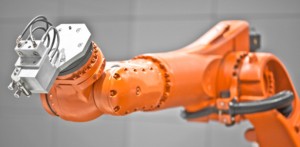
The superior quality of mould used by Tecni-Form produces the minimum visible split line
Post-mould finishing – removing mould split line
Every item produced by the Rotational and RIM moulding system will have a fine line or ridge at the point where the mould is opened. Trimming these ‘split lines’ (or ‘de-flashing’) is an essential part of the finishing process on most rotomoulded plastic components. This is an area where the quality of the original mould shows clearly. The superior quality of mould used by Tecni-Form produces the minimum visible split line.
Adding apertures, holes, thread screws, and slots
In most cases the rotomoulding is a hollow shape without any openings but most products require apertures, holes, slots, cutouts or tapped screw threads. These processes are part of the Tecni-Form service.
Tecni-Form use a number of tools and techniques to provide these features. For precision a CNC machining centre or robot routing cell is employed. Where appropriate, other machine tools such as drills, punches, hole saws and routers are used.
For moulded PU products the normal convention is to mould features such as slots, apertures and holes. However the CNC and robotic trimming techniques offered by Tecni-Form allow these features to be put in post-moulding giving designers a greater flexibility by allowing different variants to be made from a common mould tool.
After the post-moulding finishing process, Tecni-Form can take the process one stage further, and assemble moulded parts with bought-in components to make an assembly that is ready for the customer’s production line.
Plastic to Metal and Plastic to Plastic
An assembly can be made up of any combination of rotomoulded product and bought-in components, made by any other process.
Here are four examples where Tecni-Form can provide an assembly service, so saving the customer time, effort, and cost:
- The plastic roof of a tractor cabin needs to include wiring harnesses for lights and screen-washer nozzles with tubing, in addition to the roof-mounting studs that are either moulded-in or subsequently installed.
- A customer requires a fuel tank to include a metal filler cap, inlet and outlet fuel ports, an injection-moulded plastic drain plug, and a sender unit and filter, so that the component is ready to fit directly to the vehicle.
- An automotive manufacturer requires four different rotationally moulded parts to be fastened together, then fitted with metal and injection moulded plates. Tecni-Form achieve this very precisely using a jig and a combination of riveting and plastic welding.
- Using a solvent, Tecni-Form securely weld a rotationally moulded PVC squeeze bulb to a plastic tube for a medical supplier.
